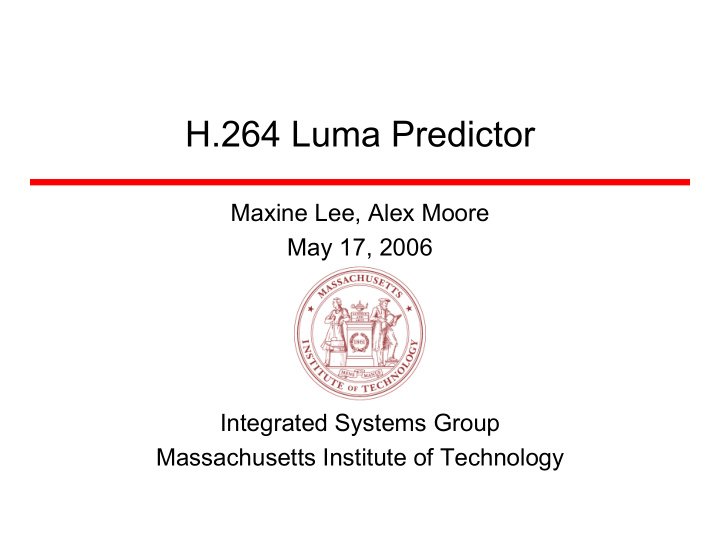



H.264 Luma Predictor Maxine Lee, Alex Moore May 17, 2006 Integrated Systems Group Massachusetts Institute of Technology
Why H.264? � End-to-end protocol � Better compression � Designed for efficient encoding � ITU standard � It’s on your iPod Integrated Systems Group 2
Project Scope � Prediction module of H.264 Encoder � Intraframe Prediction � Interframe Prediction � Transforms � Luma only (no color information!) � Why? � 85%+ of encoder computation time � Rich problem with lots of exploration Integrated Systems Group 3
Intraframe Prediction Motivation Integrated Systems Group 4
Intraframe Prediction Block Diagram Integrated Systems Group 5
Interframe Prediction Integrated Systems Group 6
Intra-Frame Prediction � Use spatial similarities to compress each frame � Use neighboring pixels to make a prediction on a block � Transmit the difference between actual and predicted � Tradeoff : prediction accuracy vs. # control bits Huge homogenous gradient � H.264 Answer : 4x4 and 16x16 prediction ! Integrated Systems Group 7
Intra – 4x4 Prediction Previously predicted and reconstructed blocks Current Pixels 9 prediction modes � Prediction proceeds left � to right, top to bottom When not all boundary � pixels available (i.e. we’re at border of picture), can’t predict with all the modes Integrated Systems Group 8
Intra - 16x16 Prediction Mode 0 : Vertical Mode 1 : Horizontal Mode 2 : DC Mode 3 : Plane average Integrated Systems Group 9
Advantages/Disadvantages Intra 16x16 Intra 4x4 � Good for smooth areas � Good for detailed areas � Lots of options � 4 modes = 2 � 9 modes = 4 bits for every 16 pixels (!) � Encoder’s job to compare options and pick the best � Exhaustive search … � Uses a cost function to compare different modes Integrated Systems Group 10
Block Diagram (Baseline) Picture Parsing Input video DCT Quant Config Choose Prediction Mode QP Initialize prediction Get best mode – variables Send to output IDCT IQuant Loop through 16 Try all 4 modes 4x4 blocks Output (to entropy encoder) Get 16x16 Try all 9 modes 16x16 Prediction Residual Get 4x4 Compute Prediction 4x4 4x4 Cost Residual QP Compute 16x16 Cost Integrated Systems Group 11
Intra – 16x16 Considerations � Process � Loop through the available*** modes � Generate the prediction � Compute cost of residual Try all 4 modes � Cost ~ SAD ( sum of absolute diff ) � ***What’s available? Get 16x16 Prediction � Depends on location in the frame! Residual All modes possible Compute 16x16 Cost Only DC possible Integrated Systems Group 12
Intra – 4x4 Considerations � Process: � Loop through all 16 blocks Loop through 16 4x4 blocks � For each block, loop through Overhead!!! available modes � Get ***cost = SAD + 4*P* λ (QP) Try all 9 modes � Pick best mode – send to DCT Get 4x4 Compute Prediction � Save reconstructed 4x4 block, 4x4 Cost Residual so you can use it to predict the QP next 4x4 block � Cost : � f ( QP ), since overhead bits A hurt more with higher compression B � P : most probable mode Integrated Systems Group 13
Extra Concerns with Intra 4x4 � Which boundary pixels do you use? � Boundary depends on where in the picture you are AND which 4x4 block you’re working on Upper right pixels not available Only left (can extrapolate) boundary available, and in another macroblock Integrated Systems Group 14
Storing Boundary Pixels To predict current macroblock, � need pixels from FOUR neighbors (A-D) D can be stored in a register, � since it is immediately used Pixels for previous row (A-C) A B C � have to be stored in a register file D Also save A in register to limit � regfile reads to 2 Integrated Systems Group 15
Synthesis Numbers Note: not P+R – not enough RAM / hard disk (ask us tomorrow if you’re really curious about P+R numbers ) � Total Area = 609,940 um^2 Predictor 66% DCT/IDCT 10% Quant (with QP lookup tables ) 15% Misc. 9% � Clock Cycle = 7.27 ns (quant multiplications) Integrated Systems Group 16
Only Three Regions of Change Integrated Systems Group 17
Interframe Prediction � Use previous frame(s) to predict macroblocks of current frame � Most of the time, majority of frame isn’t moving � If change within macroblock is sufficiently small, just reproduce it exactly! Integrated Systems Group 18
Interframe Prediction Integrated Systems Group 19
Interframe Prediction Integrated Systems Group 20
Interprediction Algorithm � Use a motion vector to predict the current macroblock. � Start at (0,0) – same block – and calculate error for each motion vector � Full-Search algorithm. Try all possible motion vectors within a window � Final prediction will be block given by motion vector with minimum error Integrated Systems Group 21
Interprediction Algorithm Integrated Systems Group 22
Interprediction Algorithm Integrated Systems Group 23
Interprediction Algorithm Integrated Systems Group 24
Interprediction Algorithm Integrated Systems Group 25
Problem… � Assume a window size of 16 (conservative) � 1024 possible motion vectors to check per macroblock (vs. 9 for intra) � 307200 possible motion vectors per frame! Integrated Systems Group 26
Solution � A better algorithm! Assume motion estimation gets better as we get closer to ideal motion vector. � Diamond-shaped algorithm reduces points checked by ~80% with mean error per pixel about 3 (vs about 2) for FS. � Hexagonal algorithm reduces by another ~35% (3.2 mean error vs 3.0) Integrated Systems Group 27
Hexagonal Algorithm Integrated Systems Group 28
Circuit Implementation Residual Predict Transforms And Cost Control Network Layer Frame Buffer Integrated Systems Group 29
Results… � Results? What Results? � H.264 predictor ~40x size of SMIPS processor � Frame buffer adds ~18000 area (+4%) � But we’re cheating (64x48 video size) � Interprediction block adds ~35000 area (+7%) � Performance evaluation TBA Integrated Systems Group 30
References Integrated Systems Group 31
Recommend
More recommend